#the end of reconstruction
Text
Reconstruction did not fail in one sense, it was overthrown:
In the end Reconstruction failed, not from rule of law, but rule of terrorism and the collapse of will on the part of the white North to enforce rule of law on behalf of Black people, North or South. The conventional war of the great armies ended, the war transformed into a guerrilla war of night riders versus US troops and Black people on behalf of a new world of white supremacy, of sharecroppers who created a pale ghost of slavery, and the one-party rule of the Bourbon Democrats.
Each of the states of the former Confederacy had a version of this process. Tenuously held Republican governments that allowed for Black participation in state and federal legislative representation, in one case as Governor. These systems were carefully held by a coalition of white and Black leaders reinforced with the weight of US occupation forces.
In the end this alliance was based on something too weak to hold, a center that was too fragile, and in the end white Northerners happily sacrificed Black people for their own convenience. In this Great Betrayal of 1877 is why Reconstruction is taught so much less than the War of the Rebellion itself.
#lightdancer comments on history#reconstruction era#'redemption'#the end of reconstruction#black resistance
2 notes
·
View notes
Text






dinah lance (and roy harper) in green arrow 2023 #4
#fighting for my life against the crusty ass rco scans for this...#i think i gave up by the end u can see the quality of my reconstructions getting slowly worse#anyway in this issue she was so... well. hm. lesbianism#dinah lance#roy harper#<- this isn't about him#ga#dc#dcedit#mine
159 notes
·
View notes
Photo

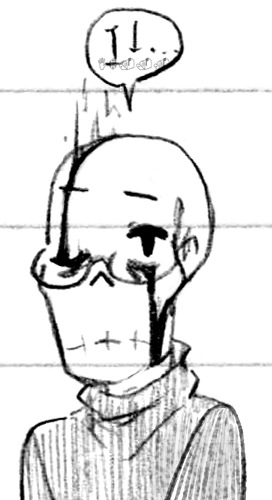
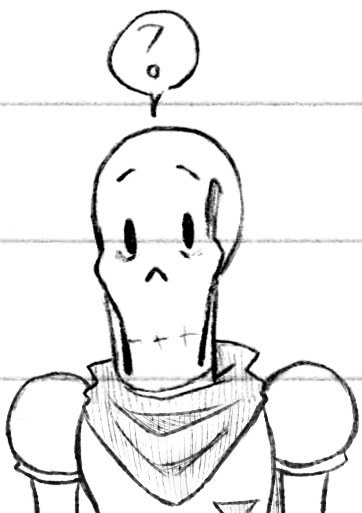
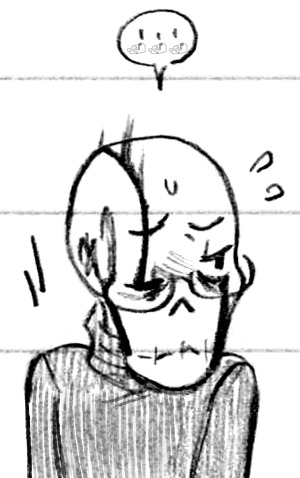
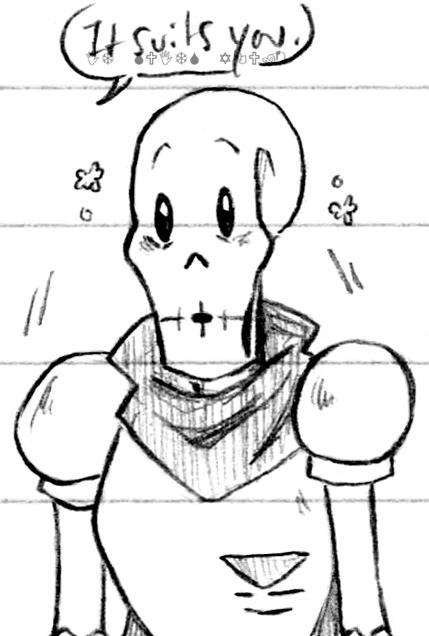


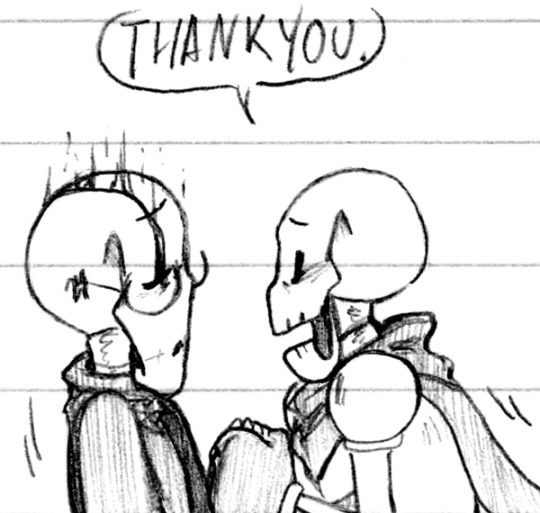
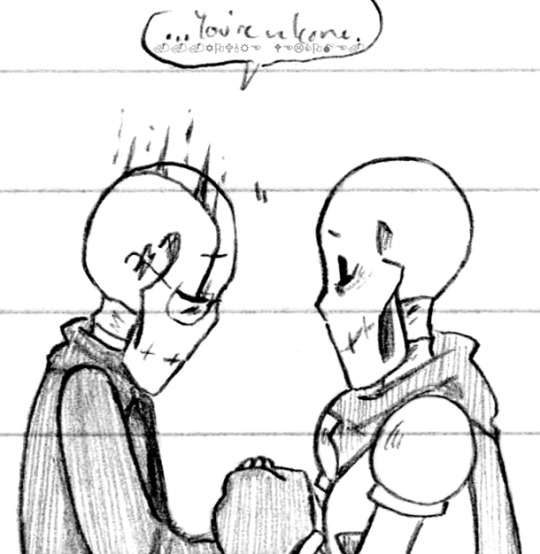
Gift (Patreon)
#Doodles#UT#Handplates#Gaster#Papyrus#Second go around! Maybe he can talk about it with the one who actually got the scarf!#Or not haha - better to just let some things lie#Though ♪ Of course Papyrus would recognize Gaster's efforts ♥ His emotional intelligence hhhh <3#He knows everything there was Gaster's initially and so reading between the lines of Gaster telling him he can have it#It's a gift! Properly! That deserves praise!! Good job you did something nice!#I also deeply love when Gaster is first pulled back out how one of his first little smiles is at Papyrus being silly#Gaster is also very prideful! It's cute to see his son being self-aggrandizing in that kid way! Seeing him enjoy it is so nice ;;#Also I know that Papyrus is still shorter than Gaster I just really like the idea of him being almost his dad's height ;;#He's so grown up now! He's grown into such a beautiful adult <3#It does make sense that he's still shorter considering the whole ''torn in half'' thing ahh#Maybe Gaster is leaning down just let me have this lol#I also ended up doing a lot of digital reconstruction on this one!#Especially panels 2 through 4 - I actually pulled out my tablet to draw in the bits that got cut off by the surrounding doodles#I wasn't as careful with my spacing with these oops :P But I think they turned out pretty style-matched :)#Cute lads happy <3
63 notes
·
View notes
Text
For my ranting and your John Simm ASMR purposes: the Masterful bts where he briefly discusses his Master.
Sth sth RTD really leaning into the concept of the Master being the Doctor's equal and mirror not erring sinner to redeem or clown to dismiss again tensimm is a symphony, sth sth the grotesque "mutantness" in EOT serving as a mockery of both Ten's and Rassilon's refusal to die and ironically enough he's the only of the three to keep this body sth sth the final reduction to a sum total of classic Masters acting no longer as the Doctor's shadow only his own future's in what is ultimately a deeply pessimistic story of one's past making moving forward impossible compare with Masterful itself where in all threads it's always the later regeneration that fucks up ANYWAY DO YOU GUYS HEAR WHAT HE'S MURMURING WHILE CALLING S10 THE LAST TIME HE APPEARED?????????
#also sir jacobi being precious and simm fanboying over him 🥰#wearing that clown makeup until the last 60th minute rips it off along with my skin#doctor who#doctor who big finish#masterful#the master#jacobi!master#simm!master#i don't want happy endings or pessimism i want joyful destruction as a condition for reconstruction#shitposting is fair use right?
71 notes
·
View notes
Text
the majority voted for me to not photoshop and just work on the valentines day art to be posted later in the month. and yea I will do that. but I already started photoshoping regardless. so happy belated birthday Grelle!!

I was originally making William into Sebster, plus Nardo's face shape worked a lot more for William than it did for Sebs, and could I have just imported a whole new face in there? yea, but it would have taken longer, may not have looked great... plus I accepted that in the end, I do afterall headcanon Bassy to be Grelle's side toy while Will is her main. so she would want this.
#fine#but you know what Grelle looks happy and so does Will I can feel it so I'm accepting it#we're all happy? good#happy belated birthday girlie!! my photoshop's still a little rough but I hope I got to capture some of your beauty ;D#in the end it's impossible for this not to look atleast a little weird but try to just enjoy the moment. and don't zoom into the details#pretty pretty please#kuroshitsuji#black butler#kuroshitsuji fanart#fanart#photoshop#digital art#grelle sutcliff#grell sutcliff#william t spears#Im sureee I would have finished this on time but oh nooo minor illness got me😔 this world really do hate my girl. but we're good now#whether we like it or not#oh yea and don't zoom into the manga panel either. not my best reconstruction really but I didn't think it needed too much#hopefully it doesn't distract from the main attraction
177 notes
·
View notes
Text
i really like when i see fahrenheit 451 on banned book lists because like. whoever decided it was going to be banned in whatever situation really thought they could justify banning a book about how banning books is bad? you’re doing this to yourself.
#and it’s not like they get gay or anything at the end#farenheit 451 spoilers#in the next tag#THEY RECONSTRUCT THE BIBLE#fahrenheit 451#ray bradbury
68 notes
·
View notes
Text
I feel like as the resident dishonor/honor guy enjoyer I have to speak on honor as a construct and how it seems to operate in asoiaf in my eyes. I will be stating the obvious here imo but: violence IS inherent to it. Be it directly or through the enablement of it. “Honor”, as a feudalistic moral construct, revolves around the reinforcement of a status quo. It is a moral construct that is embedded into a feudalistic structure, one that is inherently violent. It can be deeply flawed and destructive as a result of deeply rooted systemic issues. Being “honorable” is very complicated because, again, it does not exist based on a very sensible moral framework. It ends up contradicting itself because the way society is structured in Westeros.

Almost nothing embodies this more clearly than the KG. They are supposed to be the paragons of honor: an unsoiled white cloak.



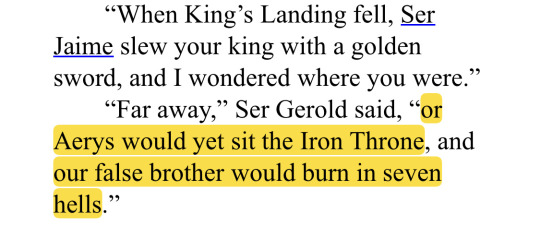

Vows are social contracts this society is built on. This is why Jaime is very restricted in a lot of ways in his world by his label. Breaking one of the most important contracts (one that happens to be key in reinforcing a feudalistic structure: it places the king’s will above every single other moral or ethical code) makes it so he is not believed or trusted and he is unable to operate properly within their society in a lot of circumstances, as we witness in his chapters. It is honorable to protect the weak and the innocent, but it is honorable to protect your king in all circumstances and reinforce a status quo. To obey your family and play your societal role. To obey laws, even if they are unjust. To keep your word, to be honest. Loyalty to a tyrant has to be inherently more honorable (especially in certain positions) to maintain this status quo, even though it contradicts other oaths and we know it is inherently immoral. Balancing values is the most interesting aspect of characters dealing with ‘honor’ and morality. Feudalism is what makes the honor system collapse. Honor itself can be a more vague concept, “the quality of knowing and doing what is morally right”, but the way it is defined and how it operates within this society is so fucked. The KG appear in the weirwood dream (mirroring the imagery of The Others, conflating the honorable white cloak with snow and cold and death.) “You swore to keep your king safe” “and the children as well.” Yeah, the innocent children of kingslanding as well, that would have burned to ash. It is honorable to save your king, to protect the weak, to save the children, to save the innocents of KG, to obey your father. He tells this to them in the dream, he explains his reasoning for killing Aerys, but they do not budge. That is what Jaime fears the most, the complete collapse of everything that holds meaning to him, heroism becoming undefinable with these conflicting moral codes, which is likely another huge part of him keeping it a secret. It is something he feels powerless against. The way things are prioritized is wrong. Morality becomes skewed. In Jaime’s mind the enemy and primary source of doom is this nonsensical moral construct that contradicts itself represented by institutions that make no sense. It is what makes his symbolic fire go out. His moral code conflicts with this society’s code of ethics, which eventually leads him to cynically accept amorality. It is disillusionment that tears the idea of heroism and being “honorable” apart and leads to moral nihilism.
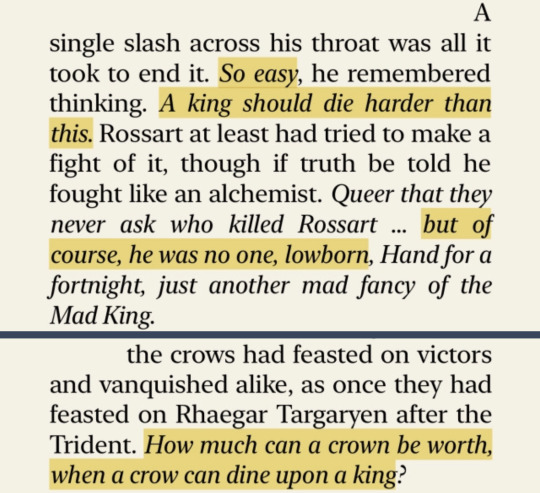
Another aspect of the honor code and its violence is the fact that it places more value to individuals based on class. It is dependent on class and a flawed social structure. This is despite the fact that vows of knighthood call for the protection of those that are too weak to protect themselves: the underprivileged. Jaime keeps having this epiphany of an inherent equality in death that seems to contradict the way society is structured. Aerys’ life is worth inherently more according to the honor code than Rhaella’s, than the lives of thousands of innocents, than Jaime’s. Yet, a lowborn hand, no one, seems to die harder than Aerys does (and nobody cares). A crown is worth nothing when crows feast on victors and vanquished alike, and the rightful heir himself. We are all equal in death, so the text is indicating that something is not right here.
When it comes to characters and their relationship with honor the important through-line is examining whether they are being “honorable” in the abstract sense, if they base their actions around empathy and a sense of actual justice, or if they are abiding by made up flawed constructs. Being viewed as honorable by this society does not make you a good person. In fact, in order for you to abide by the honor code you would likely have to turn into an amoral individual. For example, if you try to keep the cloak pure white you will metaphorically soil it. Like every one of Aerys’s kingsguard did. To keep their oath to the king, they broke vows to protect innocents and protect women. They should lose their honor by a lot of definitions, but that would mean the status quo collapses. Jaime’s knighting for this reason is very much like a boy being sacrificed at an altar. It is not just about drawing a parallel between young girls and boys being sentenced to bloody doom by violent constructs created for their gender.

“Blood is the seal of our devotion.” He bleeds on his plain white tunic. It was never “pure white”, it was always all tainted in blood. It is inherently violent. You can argue that is when “the boy died.”
Very rigid and hypocritical honor codes built for feudalism lack nuance and lead to amorality. I think George aims to address, interrogate, deconstruct, and then reconstruct honor, as with most other key concepts present in fantasy. Honor can be redefined. Examples like “No chance, and no choice”, among many others, are at the root of that reconstruction. Even then, the reconstruction does not conflate it with pacifism necessarily. For example, Chelsted did the ‘honorable’ thing, in the abstract moral sense, of quitting his job and not supporting a tyrant anymore, but that act achieved nothing in preventing the wildfire plot. Same with essentially everyone important at court abandoning the situation that is Aerys, turning away from a gaping wound and not addressing it before it was too late. Jaime had to soil the ‘white cloak’ and disrupt the status quo and lose his “honor” within those terms by murdering his king and his pyromancers as a kingsguard and actually save half a million lives. It was not glorious, nor was it anything like the songs, and the city is still doomed because there is no way to get that festering corruption out of there at this point, metaphorical of the greater problem with KG, but it was heroism, a choice with meaning, and a form of triumph, even if the consequences break Jaime down the line. He gets no answer to the question of what it means to be a knight and a man of honor if society’s version of it is so skewed. Then, Jaime and the readers get an answer in the form of Brienne: “I dreamed of you.”
#anyways what is honor? a horse#valyrianscrolls#theres also the aspect that honor is kind of individualized#its ‘your’ honor etc#like i think there r nuances in whether its treated as something internal or external#and at the end of asos hope is rekindled in jaime#but he desperately blinds himself trying to make the contradictions compromise#thats y he is suddenly reconstructing his thoughts about the kg and escapes int delusion#bc he has too many things that he still wants like cersei like his family and loved ones like the possibility of making ppl view him#as something redeemable someone good#but feast concludes that that is not possible#so all there is left is a pivot and brienne’s light#and a confrontation w so many things that have been repressed in order to keep him from essentially killing himself tbh#and nothing encapsulates that dilemma bw honor vs ‘honor’ than jaimes punitive justice against outlaws and his vow to cat#thats y its so significant that he abandons it to go w brienne alone to save sansa instead of pursuing the blackfish#and how he doesnt torch the village or even break in even if they hold info re the brotherhood#and then the irony is that that key choice will lead him to them#and what happens there is gonna be so interesting
122 notes
·
View notes
Text
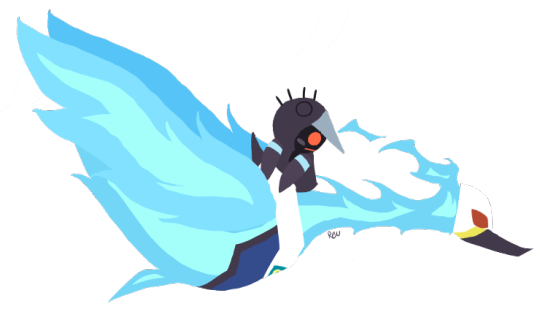

I ended up doing another drawing of Cygnus and I also wanted to try drawing Cygnus Wing
#mega man star force#megaman starforce#megaman star force#mmsf#cygnus mmsf#cygnus wing#spoilers in tags#i think#I ended up learning that he comes back as Tom's Wizard in 3 and I haven't stopped wondering how that must've gone down#I'm kind of tempted to try writing something myself since I didn't find much beyond “the Hunter VG reconstructed him”
27 notes
·
View notes
Text
the fact that it's specifically stated that faulkner lied when he said no one else knew about the house is so funny to me because
a) im used to things specifically mentioned in writing coming back and the idea of carpenter being like "well i know a place we can crash at" and her and hayward walking into the cabin and seeing faulkner n rane just standing there is unquestionably hilarious but also
b) it means that faulkner had to have told her about his past at some point and that means that when he asked to be her brother she had fully acknowledged the fact that faulkner killed one of his brothers in a traumatic misunderstanding he's reconstructed in his mind as a good thing As Well As the fact that her last brother died in an act of religious self-sacrifice, and said yes. with her little caveat. just mentally grabbing him by the collar like "listen. i don't want you to kill yourself for your god. and i hope you don't want to kill me for your god. and if either happens i am going to kick your ass in hell when both of us get there"
#eternally fascinating to me how there was setup placed at the end of s2 for faulk's cycle to come to fruition in s3 - killing carp and#reconstructing it in his head as a good and necessary part of the prophet's legend#but now it's tipped more towards carpenter's cycle - watching another brother die for the same god#except there's a twist! because it's not religious self-sacrifice this time - just standard “not seeing a way out other than death”#and if he succeeds again... well... she did dream about a tree that one time. and a lot of dead people have been turning into trees lately.#wild if true. anyway#tsv#carp n faulk#brother faulkner#sister carpenter#eyeteeth speaks#siblings of all time i love them. mallory n richie 4ever.
16 notes
·
View notes
Text
monkees things we have actual footage of:
monkees sharing a bed ❤
monkees gay joke
micky catboy dolenz. meowing
oh look at the size of that fist...and the arm....oh wow. god, lovey, youre just really all right
monkees switching shirts literally within the same episode
mike nesmith enthusiatically doing drag
all monkees doing drag with varying levels of enthusiasm
the monkees undressing eachother onscreen
mike nesmith maid outfit
monkees leather butch episode
"i think hes kind cute" "you would."
bondage
#sorry for that last one i needed the post to end on maximum impact. sorry again#anyway stream the monkees - mikes loop head deleted scene reconstruction on youtube#emi's meandering jotts
112 notes
·
View notes
Text
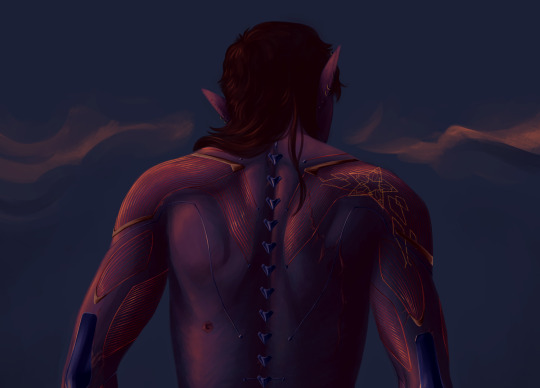
tattoo removal
#shadowrun#ghost city#Ilya Kasharin#art shenanigans#wails... posting feels like pulling teeth but I am DONE hjfdhs I completely forgot about the background until the very end#they didn't get it removed on purpose but they needed reconstructive mods and it would've been harder to keep that piece of skin intact :/
76 notes
·
View notes
Text
Louisiana was the first flashpoint of creating a post-slavery political order and it was one of the last of the end of Reconstruction:
One of the last clashes of the so-called 'Redemption' was also the one that explains the Judas role that General James Longstreet played in the Lost Cause narrative. Longstreet was the only former Confederate besides William Mahone to embrace Reconstruction at any real level. He did so to the point of leading Black troops against the Klan and the Knights of the White Camellia.
For this apostasy and his willingness to embrace a better world, he was treated as the slimy backstabbing traitor in the heart of the Army of Northern Virginia and made the scapegoat for Confederate defeats. And in the end Louisiana, one of the first flashpoints in the creation of a post-slavery order, was also the last.
#lightdancer comments on history#black history month#reconstruction era#'redemption'#the end of reconstruction#liberty place massacre
0 notes
Text
Rannoch researches - Part 1: Astrophysics, formation of the Tikkun system and origin of life on Rannoch
[Potential spoilers for the Mass Effect trilogy]
Alright, I finally, finally made it to the Rannoch arc of ME3 - and while it absolutely freaking destroyed me on an emotional level, I was nevertheless very excited to see the Quarian homeworld in person. I mean, it's one thing to just read the entries on the wiki, but virtually being there and flying around in the star system is something entirely else.
As you might know, I'm very interested in any lore about the Quarians and Geth, specifically everything that's related to Rannoch's culture previous to the Morning War, and being able to set foot on the site is like a dream come true for me. (Having an idea of the place you're researching just immensely helps with visualization. xD)
However, being my nerdy self, I decided to try and explore Rannoch's history a little further, beyond the Morning War and even the advent of Quarian civilization - that is to say, the history of Rannoch's star system. I'm aware that this topic might be a little dry to some people, since it has nothing to do with ME's story as a whole and basically just covers the scientific background. However, after researching about it, I must say that I find it to be quite fascinating, and I certainly learned a lot of things about astrophysics, the origin of life, and the universe as a whole along the way.
Disclaimer: I should mention that I'm neither an astrophysicist nor a chemist, and all my knowledge about the topic stems from self-study. Therefore, it's possible that some of my conclusions and projections might be scientifically inaccurate; if someone has more expertise in these fields than me, feel free to point any error out to me. For the sake of understandability, I will try to explain all facts as simply as possible.
The age of the Tikkun system
Before actually being able to travel to the system in Mass Effect 3, Legion already gives us a little trivia about Rannoch and its star in ME2. When Shepard inquires what the Quarian homeworld is like, they respond with:
"It is more arid than Earth. The star is older and more orange than Sol."
In combination with the information that Rannoch's star Tikkun has about 90% of the Sun's mass and half of its luminosity (which we learn from the planet's description), we can conclude two things:
Tikkun is older than 4.6 billion years (the approximate age of our Sun).
Tikkun is a K-type main-sequence star, sometimes also called orange dwarfs due to their emitted light being in the orange spectrum.
From an astrophysical perspective, these two pieces of information complement each other nicely: Since K-type stars are generally more stable than stars of the G-class like our Sun, they also have longer lifespans (about 17 - 70 billion years, in contrast to the estimated 10 billion of the Sun), which means that a K-type star that formed long before our Sun could still exist without issue.
Also, despite being colder and less luminous than G-type stars, K-type stars are considered to be of particular interest in the search for extraterrestrial life, if only for the reason that their extended lifespan gives organic life more time to develop. Furthermore, K-stars emit less total UV light and ionizing radiation than G-type stars, which are known to be damaging to DNA and thus would hinder the development of extraterrestrial life.
However, it's still debated how beneficial these presumed advantages actually are: Due to their lower heat emission, planets would have to orbit closer to K-type stars to have habitable temperatures, which might offset any benefit from a lower UV output. Also, while the total UV radiation is lower, K-type stars emit higher levels of X-rays and far ultraviolet light (F-UV) during their early lifespan, which may act sterilizing and destroy any atmosphere, thus preventing the emergence of organic life (or at least significantly delaying it).
Still, there is a factor that might have made it possible for life to develop on Rannoch after all: metallicity. Metallicity denotes the abundance of heavy elements in a star, although the term "metals" is a bit misleading - it's not about metals in the actual sense, but rather every element that is heavier than hydrogen and helium. Hydrogen and helium are the two lightest elements and the first to exist immediately after the Big Bang (in addition to small quantities of lithium), and all other elements were created by nuclear fusion in stars and then ejected into interstellar space by supernovae. Consequentially, that means the older a star is, the less heavy elements it contains (there are exceptions to this rule, however).
Now, the interesting part about this is that very recently, scientists have found out that planets orbiting metal-poor stars might actually be more habitable to organic life: Although metal-poor stars emit more total UV radiation compared to metal-rich stars, the spectrum of the emitted UV light strongly differs. Metal-poor stars emit more short-wave UV-C light, while metal-rich stars predominantly emit the longer-waved UV-B light. The difference is that while UV-B light acts destructive to any ozonosphere, UV-C light actually supports the formation of an ozone layer. It may seem like a bit of a paradox that a certain spectrum of UV light benefits the formation of an atmosphere protecting the planet from cytotoxic UV radiation, but what we can surmise is that metal-poor stars are generally more life-friendly.
However, Rannoch's star system potentially being very old by galactic standards introduces yet another problem: At first, scientists suspected that metal-rich stars are overall more likely to possess planetary systems, particularly such that include terrestrial planets. This was probably due to the assumption that since heavy elements were not that abundant in the beginning of the universe, terrestrial planets were also not very common back then, although further observation has shown that smaller exoplanets exist around stars with a range of metallicities. Evidence suggests, however, that large gas giants are more likely to form around planets with high metallicity - perhaps because cores containing a large amount of heavy elements exert a stronger gravitational force on light gases.
Still, the issue remains that the cores of planets which formed during the early phase of the universe most likely contain next to no heavy elements. This is important because the iron and nickel core of Earth is one of the main reasons life was able to develop on our planet in the first case: The heavy elements in the core are responsible for Earth's magnetic field, which stabilizes the atmosphere and protects it from being blown away by solar winds. So, presuming that Rannoch's core is composed of a larger portion of light elements, it would have a weaker magnetic field than Earth, which in turn would make it harder for the planet to develop a life-essential atmosphere.
Either way, we can surmise that the question whether a planet is actually habitable depends on various different factors, and it once again proves what a delicate balance has to be met for organic life to develop. In case of Rannoch, it's worth mentioning that Rannoch's atmosphere is stated to be slightly thinner than Earth's (0.93 atm). So, if Tikkun is indeed an old, metal-poor star, perhaps the influence of the increased UV-C radiation is just enough to offset all other atmosphere-depleting factors, like F-UV radiation, x-ray radiation, and solar winds. Also, it's noted that Haza, the only gas giant of the Tikkun system, is comparatively small; thinking back to the observations that large gas giants predominantly form around stars with high metallicity, this might suggest that the percentage of heavy elements in Haza's core is pretty low, which in turn could hint at the system's high age.
Life based on dextro amino acids - proof of Rannoch's age?
However, there might be another, even more convincing indicator that Tikkun is pretty ancient by astronomical standards: As we know, life on Rannoch is based on dextro amino acids, including the Quarians who are the only dextro species in the galaxy aside from the Turians, with all others being levo amino-based. For a long time, scientists have been speculating why lifeforms on Earth consist pretty much exclusively of L-acids (levo), and why there are sugars (e.g. glucose) consisting of D-molecules (dextro), but no proteinogenic (protein-creating) acids. Theoretically, the chemical construction of D- and L-acids is exactly the same - the only thing that's different is the way the molecules reflect light, which is clockwise for D-acids and counterclockwise for L-acids (a property known as "chirality"). This may not sound like much, but it has major consequences: As a result, D- and L-acids are entirely incompatible with each other, acting like image and mirror image. (Just as a side note because I keep hearing that Quarians consist of "completely different" molecules than humans and thus are completely different lifeforms: Broken down to their chemical components, D- and L-acids don't differ from each other at all - it's basically the same, just the other way around.)
Meanwhile, the American chemist Ronald Breslow has proposed that the reason why L-amino acids are dominant on Earth has something to do with electromagnetic radiation: Going by the panspermia hypothesis, the molecules of life spread through the universe by means of meteoroids, asteroids, comets, and other matter. However, on their way through space, these molecules are subjected to the radiation of neutron stars and pulsars, and it's been observed that dextro amino acids get destroyed more easily by neutron star radiation than their levo counterparts. Thus, the meteoroids that fell down on Earth contained more L-acids than D-acids. Since amino acids of the same kind paired up with one another and became crystallized, the only ones that remained were those that couldn't find any partner: the excess L-acids, which were dissolved in the water and eventually became the components of organic life.
Now, one thing to keep in mind is that neutron stars and pulsars are objects that form after a dying star turns into a supernova. Logically, this would mean that the older the universe gets, the more neutron stars are created, and consequentially, their number must have been lower during the early stages. If this is true, the radiation hazard must have been lower as well, and presuming that the quantity of D-amino acids contained in a meteorite exceeded those of L-acids, it could've led to life developing along an alternate path on a different planet - even Breslow himself considered it a possibility that life based on D-acids and L-sugars might exist elsewhere in the universe.
This would lead to the conclusion that the Quarians as a species are way older than humans - and potentially, the majority of the other races in the galaxy. What makes this even better is that it actually lines up very nicely with the comment from Erinya's bondmate (the Asari you meet on Illium during the sidequest "Medical Scans" in ME2) that Quarians have "old souls". (I'm not entirely sure how Asari are able to determine how old someone's soul is, but then again, I never quite understood their esoteric mindset. xD) Going from this, it might mean that the Turians are another "old" species of the galaxy, since they developed based on dextro acids as well - either way, I quite like this theory, since it not only fits in with the lore but would also make sense from a scientific point of view.
Rannoch's position in the Milky Way
However, as with pretty much all good theories, there is just one problem: Rannoch's position in the Milky Way. In 2016, scientists created the first global age map of the galaxy based on observations of 100,000 red giants, coming to the conclusion that the oldest, most metal-poor stars are located in the galaxy's center and in the halo (the roughly spherical space surrounding our galaxy, acting as a kind of "border zone"). Furthermore, they observed that with increasing distance from the galactic center, the stars of the disk (the "flat" level that the spiral arms are on) get younger the farther away they are - and with the Tikkun system being located at the disk's very edge, this puts my theory in a somewhat precarious place.
However, at the same time, the stars' age increases the greater the vertical distance from the galactic disk is (to put it simply, the oldest stars are found above and below the disk). At first, this led me to the suspicion that the Tikkun system might actually be located in the halo, since the galaxy map of Mass Effect is only in 2D and doesn't account for the 3D aspect. However, I was stopped short by the realization that the halo contains no interstellar medium - that is to say, clouds of gas and dust which are essential for the formation of solar systems. With nebulae (like the Perseus Veil) also being part of the interstellar medium, this makes a localization of Tikkun in the halo extremely unlikely. Still, one thing I did find out that Tikkun is probably located "above" most of the rest of the Milky Way: Due to the dented shape of the disk (which is suspected to be caused by the rotating movement of the galaxy's center), the regions at the outer edge of our galaxy are significantly bent upwards and downwards. I actually managed to find a three-dimensional map depicting the position of our solar system, making it possible to deduce the position of the Tikkun system in relation to it, which would most likely be located near the "raised" partition of the disk (see image below).

This 3D map of the Milky Way galaxy shows the position of our Solar system, and if compared to this Mass Effect galaxy map, we can conclude that the Tikkun system would be somewhere on the right, where the "ridge" is (Edited image; original picture source)
Still, that doesn't mean my speculations are completely off the table: In a more recent study from 2023, a team of scientists did a metallicity profile of the Milky Way's stars, starting from the galactic center all the way to the outer rim. During their survey, they not only observed a spike of metal-rich stars around 23,000 light years from the center (with 26,000 light years distance from the center, our solar system lies quite close to it), but also an unusually high quantity of metal-poor stars about 50,000 light years from the galactic center.
Granted, there is a correlation between the age of a star and metallicity, but as I already pointed out above, this doesn't always have to be the case. In fact, each of the three star populations - young, intermediate, and old - displays the trait of a higher metallicity near the center and a lower metallicity at the outskirts. Then again, the oldest, most metal-poor stars of the galaxy are also found in the center, and the research group has acknowledged that one reason for the steep decrease of metallicity near the outer edge might be that our estimates of the extent of the Milky Way's disk are off. Either way, a diagram from the study shows that old stars still exist up to a radius of 12 kpc (approx. 40,000 light years), with their luminosity decreasing the farther away from the center they're located. In the study, "old stars" were classified as those with an age of 8-12 GYR/8-12 billion years, so this would be my rough estimate for the age of the Tikkun system as well.
Another explanation for the rapid decrease of metallicity near the outer rim that has been proposed is the collision with a former, metal-poor dwarf galaxy. This galaxy would have been engulfed and later absorbed by the Milky Way, with its metal-poor gas being used as the building material for new stars. If this was true, perhaps the Perseus Veil might even be a remnant of this collision, consisting of gas formerly belonging to this dwarf galaxy. Going by the description from the Codex, the Perseus Veil is an opaque nebula in the colors of "purple and gold", suggesting that it might consist of a combination of emission nebulae (those that emit light in the visible spectrum, hence the striking colors) and dark nebulae. Dark nebulae absorb the wavelengths of light visible to the human eye, effectively concealing any stellar objects behind them (still, objects obscured by them can be observed with radio or infrared telescopes, which is a little curious considering that the Codex entry says "the Veil's total opacity prevents Council intelligence from surveying Geth activity"; however, it's possible that the Geth are using technology to disrupt those frequencies, not wanting organic races to spy on what they're doing). Dark nebulae in particular are also known to be the birthplace of many stars and planets, which makes them a likely candidate for the origin of the Tikkun system.
However, there is also the possibility that the Tikkun system might not be located in, but rather behind the nebula. The form of dark nebulae tends to be very irregular, with no clearly defined boundaries and far-ranging, serpentine shapes. In the night sky, they appear as dark patches, which is a phenomenon we know from the Great Rift, clouds of interstellar gas and dust obscuring much of our view from the Milky Way (for avid star gazers, this is indeed the dark band that stretches across the "bright band" of the Milky Way). This is due to the Rift being located between the inner edge of the Orion arm (which is the spiral arm where our Solar System is located), and the Sagittarius Arm, the next arm inward; thus, the Great Rift effectively blocks our view of the Galactic center. So, perhaps something similar might be the case for the Perseus Veil, with the Veil being located in-between the closest spiral arm and Quarian/Geth space. (This would also make sense considering that the Quarians/Geth occupied more clusters than just Tikkun, for example the Far Rim; the fact that multiple clusters are obscured by the Perseus Veil would support the theory of it being a more extensive interstellar cloud instead of a nebula that only contains the Tikkun system, despite Tikkun's cluster being labeled "Perseus Veil").
Also, keeping the 3D-perspective in mind, the elevated position of Tikkun (and probably the other systems as well) would mean that observers from other star clusters have to look "up" at them, which might indicate that the Perseus Veil is located slightly below the Tikkun system. (As an allegory, imagine spanning a dark piece of fabric between you and a lamp at your ceiling.) This allows for some interesting speculation what our galaxy might look like from Rannoch's night sky, as our position on one of the spiral arms also affects what we can see of the Milky Way. In that sense, Rannoch might even be in a more "ideal" location to observe the galaxy as a whole, its elevated position granting something like a top-down view of the Milky Way. From the northern hemisphere, you would have a good view at the stars of the halo and other galaxies, while on the southern hemisphere, you would look directly at the dark "rift" of the Perseus Veil. One might wonder what kind of influence this had on Quarian mythology - considering the huge significance stars held in human culture, we can assume that the same is true for the Quarians, if not more.
Organic life: a temporary phenomenon?
Anyway, regardless whether my theories are true or not, I certainly found it very interesting to think about how life could've developed on a planet like Rannoch, and I think the possibility of there being an extraterrestrial civilization which is much older than ours is extremely fascinating. Still, one thing my researches taught me is that on a galactic level, creation and destruction often lie very close together: When a star dies and goes supernova, all life on the planets around it is naturally extinguished. However, the gas and matter from the dying star go on to become the building material for a new generation of stars, thus creating a new chance for life to emerge on other planets. The interesting question is though whether this cycle will continue indefinitely, or if there is some kind of natural limit to it. (As a fair warning, this is about to get a little existential.)
What stirred this thought in me is the observation that with growing age, the universe will become increasingly hostile to life, as each new generation of stars will contain more heavy elements. As explained above, this will lead to the stars emitting more hazardous radiation, which at some point could reach an amount that prevents the development of life altogether. So: Does that mean that organic life is really just a temporary phenomenon, and is our existence nothing more than a tiny episode in the grand history of the universe?
Regarding Mass Effect specifically, I wonder whether the Reapers are actually aware of this - I mean, a universe without life might mean that they'd be potentially jobless at some point. xD On the other hand, perhaps this is precisely the motivation behind their harvests: If organic life is truly just "an accident", as Sovereign says, maybe this is why the Reapers were talking about the "ascent" of humanity when turning all of them into a giant bio-machine in ME2. Maybe they actually intend to bypass the pre-destined extinction of organic races by lifting them onto a higher evolutionary plane.
Before you ask, yes, I've played the Leviathan DLC, and yes, I'm aware what the Reapers' purpose is in canon - however, I couldn't help but feel that the explanation of "AI and organics are destined to fight" is a tad bit lame, and on top of that, it leaves open so many plot holes and loose ends that never get addressed. So, I guess I would've preferred if they went with a more philosophical approach like this. (Especially since it not only seems to be implied, but also fits the overall setting quite well.)
Anyway, that's enough talk for today - I hope you enjoyed this deep dive into Rannoch's astrophysical background, as well as my conjectures how it all may fit in with real-life science. I'm definitely planning to make this into a longer series, but I need to figure out how day and year cycles work on Rannoch first. In fact, if anyone of you has sufficient mathematical knowledge, I would be very grateful for any assistance in calculating how fast time passes on Rannoch - we do know that it has a slightly lower gravitation than Earth (0.89 g), and since theory of relativity exists, that means time passes faster on Rannoch than on our planet.
It might take me a while before I'll be able to continue this series (if simply for the reason that posts like these take a lot of time and effort to make), but still, thank you for your attention!
#mass effect#mass effect lore#lore theories#quarians#rannoch#science#astronomy#astrophysics#fictional astrobiology#I just reconstructed the hypothetical history of a planet that doesn't even exist#funny how real-life science is more helpful to me than BioWare's own lore#dang it I did NOT mean to go that existential near the end but I suppose I did lol
28 notes
·
View notes
Text
god the announcement of hnk (houseki no kuni/land of the lustrous) has got me in shambles,,, i haven't read the chapters after the 10 000 years hiatus so i gotta catch up (actually I'll probably re-read the whole thing)
‼️rambling incoming‼️
imo, hnk is one of the best series for deep psychological analysis,,, it had such a deep impact on me when i first read it (like 3 years ago) and still remains in my top best/favorites series 🥹🥹 i could ramble abt it for so long,,, the process of one losing bit by bit the parts of themselves and replacing it with something else (both physically and metaphorically) in an endless need to help others, but also as an own selfish wish to become better than who they used to be. Then looking back, and realizing things were so much simpler back then, and mourning that past self. (The fact that all of this revolves around their self-hatred and the belief that they're worthless is just. It's so heartbreaking to me. They've become so desperate for affirmation and yet still keeps getting hurt, by others and by themself too.)
i have too many feelings about the manga 😭😭 im losing myself to the brainrot, help-
#leaf yapping#hnk#any hnk fans here?? 🥺🥺#I MEAN IT WAS PRETTY OBVIOUS THE SERIES WAS GOING TO END SOON ANYWAYS#god I still remember the infamous 2 years hiatus#all because ichikawa got a ps5#i have so many thoughts on so many characters#rutile...ghost quartz...diamond...yellow diamond...antARCTICITE...CINNABAR??? CAIRNGORM???? 😭😭😭#and last but not least. lets not forget our endlessly suffering protagonist. gods sacrifical lamb.#IM NEVER GOING TO SHUT UP ABOUT PHOS‼️‼️#this series made me so mentally ill...like i was already mentally ill but it made me worse#i rewatched the anime recently actually and it made me super emotional 🥹🥹#ichikawa. when i catch you ichikawa.#THE TRANSFORMATION PHOS WENT THROUGH IS SO INSANE ACTUALLY#ur telling me the silliest little guy is now...some imposing shapeless deity figure???#lets not forget about when [spoiler incoming]#they lost their legs. then lost their arms. then lost their head.#then got destroyed and slowly reconstructed into a horrifying mix match of broken pieces#not the mention how they get shattered by the alloy when they have a mental breakdown#WHICH IS SUCH AN INSANE DETAIL BTW???#the way they just. fully physically break down to pieces. from inside of themselves. when their mind is spiralling.#i think their portrayal of ones trauma is so interesting#ANYWAYS IM STOPPING MY RAMBLING FOR NOW
11 notes
·
View notes
Text
Archive 81 tv show made Melody Pendras straight we cannot trust podcasts in the hands of mainstream media !!!!!!!
#archive 81#I have mixed feelings about it and as soon as they introduced Gal Pal Annabelle to replace Actual Girlfriend Alexa it should have been a#red flag#conceptually I really liked what they did to flesh out the first season#but they took it in a completely different direction by the end and at that point it’s not even the same thing anymore 🙄#like you can’t even pick up anything from the original’s season 2 because they reconstructed the narrative so much#idk man its not like they’re going to make any more of it anyways but I still felt the need to come on here and bitch#honestly main stream adaptations of podcasts scare me like I revel in exposure for things I like but ultimately so much gets lost in#translation#like archive 81 podcast is weird and nonsensical at times and Tape Recorder Man’s adventures in the Upside Down just don’t translate to a#general audience ? so they gotta bring in reasons for it to make sense like satanism and witches and demons#when that was sooooooo not the point of the original#like seeing how much they had to adjust to appeal to an outside audience makes me almost glad the wtnv tv show didn’t get green lit#can you imagine ???? how the fuck would they get five headed dragon Hiram McDaniel on my actual television ????#standing next to a Cecil Palmer with a canon appearance no less#like adaptations are cool and they CAN work sometimes but if you’re going to have to break and bend the world in order to make it to the#point where it’s a new thing entirely#ESPECIALLY since we live in a world where audio drama is not respected as a creative medium#at that point I’m just like leave it alone it’s fine on it’s own#anyways archive 81 is an interesting experiment into what live action podcast adaptations COULD look like but you can pry lesbian Melody#Pendras from my cold dead hands and that makes the adaptation automatically inferior imo#I guess she could be bi but when you remove Canon Girlfriend and instead make her kiss a man ? not likely#I am just talking to hear myself talk now goodbye#max rambles in the tags
26 notes
·
View notes
Text
i do think its kinda funny when i see someone in the year of our lord 2024 talk about vocal synth music like its all gone downhill since like 2010 because like dont get me wrong i love a good niconicodouga-ass 2008 ass vocaloid joint BUT also like. the past couple years have had the most fascinatingly creative and expressive uses of vocal synthesizers ive ever heard in my life DJFSKHJDFS dont write it all off just yet!!
#usually i only see that from people who havent actually listened to any vsynth music from the past 15 years so i understand why they got to#that conclusion. and also usually theyre people who didnt listen to much vsynth music in the first place LOL they just dont know#but it is still a little funny. brother there are things beyond your wildest dreams if u just look#like some personal highlights: the stuff by rinri - particularly their use of the meika girlies#dont carry our memories away is LIFECHANGING the whispers. the spoken parts. the BELTS#plus the haunting and unrelenting instrumentation. fantastic song#and naisho no pierced's propose + birthday + gift sort of trilogy of songs. gift especially has been unreal#again the dynamics of soft intimate whispers to belts but also those fuller high notes with edges of growlyness.#plus the songs just generally rock. and those LYRICS. absolutely intense like physically painful and frightening like#yearning and codependency and possession. and the tuning and production just amps it up more#OH and slave.v.v.r has been doing crazy things for even longer but i only started getting into his stuff recently and holy shit#love eater is like. the scariest vocaloid song ive ever heard not because of the lyrics. but because of the tuning#im like. scared. i cant stop listening to it. the heavy synthesized breathy main vocals and whispered harmonies plus the VOCAL FRY#i didnt realized vocaloid5? i think? has a vocal fry option built in i heard? thats crazy#but specifically in love eater the fry and growl is amped up so deep and loud and clear compared to everything else it like#emphasizes the artificiality of the voice while also amping up the expressiveness#its awesome. and on the older slave.v.v.r songs i heard i will hit you 8759632145 times with this piano. also so fucking cool#addicted to that song. 1) its a great jazzy rocky piano tune with this piano flourish at the end of each phrase that sounds fantastic#but also 2) the lyrics are insane. using kanji to write english??????#people are doing wild ass things with vocal synths rn you guys#this isnt even getting into some of the really unique synths themselves too. adachi rei is awesome i love that shes just like#the perfect inbetween of sample based and reconstruction based vocals. shes a sample based synth#but her samples were drawn by hand LOL shes like dectalks granddaughter to me.....#a really good use of adachi rei is iyowa's heat abnormal/heat anomaly/whatever its called ITS AWESOME thats what it is hjrkfdgfd#i think the fact that vocal synths can be so realistic and clean and noiseless out the gate now has made people really stop worrying#about like. realism all together and looking more into expressiveness. omg vocal synth modernist movement
7 notes
·
View notes